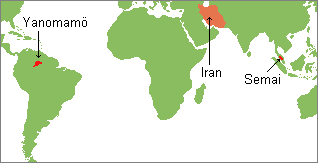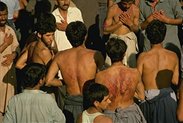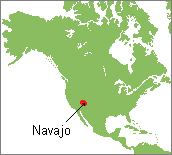Socialization
Human infants are born without any culture.
They must be transformed by their parents, teachers, and others into cultural
and socially adept
animals. The general process of acquiring culture is referred to as
socialization
![]() . During socialization, we learn
the language of the culture we are born into as well as the roles we are to
play in life. For instance, girls learn how to be daughters, sisters,
friends, wives, and mothers. In addition, they learn about the
occupational roles that their society has in store for them. We also learn and usually adopt our culture's norms
. During socialization, we learn
the language of the culture we are born into as well as the roles we are to
play in life. For instance, girls learn how to be daughters, sisters,
friends, wives, and mothers. In addition, they learn about the
occupational roles that their society has in store for them. We also learn and usually adopt our culture's norms
![]() through the socialization process.
Norms are the conceptions of appropriate and expected behavior that are held
by most members of the society. While socialization refers to the
general process of acquiring culture, anthropologists use the term
enculturation
through the socialization process.
Norms are the conceptions of appropriate and expected behavior that are held
by most members of the society. While socialization refers to the
general process of acquiring culture, anthropologists use the term
enculturation
![]() for the process of being socialized to a particular culture.
You were enculturated to your specific culture by your parents and the other
people who raised you.
for the process of being socialized to a particular culture.
You were enculturated to your specific culture by your parents and the other
people who raised you.
 |
|
Socialization is important in the process of
personality formation. While much of human personality is the result of
our genes, the socialization process can mold it in particular directions by
encouraging specific beliefs and attitudes as well as selectively providing
experiences. This very likely accounts for much of the difference between the
common personality types in one society in comparison to another. For
instance, the Semai
![]() tribesmen of the central Malay Peninsula of Malaysia typically are gentle
people who do not like violent, aggressive individuals. In fact, they
avoid them whenever possible. In
contrast, the Yanomam
tribesmen of the central Malay Peninsula of Malaysia typically are gentle
people who do not like violent, aggressive individuals. In fact, they
avoid them whenever possible. In
contrast, the Yanomam
![]() Indians on the border area between Venezuela and Brazil usually train their
boys to be tough and aggressive. The ideal Yanomam man does not shrink
from violence and strong emotions. In fact, he seeks them out.
Likewise, Shiite Muslim men of Iran are expected at times to publicly express
their religious faith through the emotionally powerful act of self-inflicted
pain.
Indians on the border area between Venezuela and Brazil usually train their
boys to be tough and aggressive. The ideal Yanomam man does not shrink
from violence and strong emotions. In fact, he seeks them out.
Likewise, Shiite Muslim men of Iran are expected at times to publicly express
their religious faith through the emotionally powerful act of self-inflicted
pain.
 |
Shiite Muslim men in
Iran ritually beating themselves bloody with hands and chains as an act of religious faith commemorating the death of Imam Hussein in 680 a.d. |
|
|
|
|
standard school |
|
Successful socialization can result in uniformity within a society. If all children receive the same socialization, it is likely that they will share the same beliefs and expectations. This fact has been a strong motivation for national governments around the world to standardize education and make it compulsory for all children. Deciding what things will be taught and how they are taught is a powerful political tool for controlling people. Those who internalize the norms of society are less likely to break the law or to want radical social changes. In all societies, however, there are individuals who do not conform to culturally defined standards of normalcy because they were "abnormally" socialized, which is to say that they have not internalized the norms of society. These people are usually labeled by their society as deviant or even mentally ill.
Large-scale societies, such as the United States, are usually composed of many ethnic groups. As a consequence, early socialization in different families often varies in techniques, goals, and expectations. Since these complex societies are not culturally homogenous, they do not have unanimous agreement about what should be the shared norms. Not surprisingly, this national ambiguity usually results in more tolerance of social deviancy--it is more acceptable to be different in appearance, personality, and actions in such large-scale societies.
How are Children Socialized?
Socialization is a learning process that begins shortly after birth. Early childhood is the period of the most intense and the most crucial socialization. It is then that we acquire language and learn the fundamentals of our culture. It is also when much of our personality takes shape. However, we continue to be socialized throughout our lives. As we age, we enter new statuses and need to learn the appropriate roles for them. We also have experiences that teach us lessons and potentially lead us to alter our expectations, beliefs, and personality. For instance, the experience of being raped is likely to cause a woman to be distrustful of others.
Looking around the world, we see that different cultures use different techniques to socialize their children. There are two broad types of teaching methods--formal and informal. Formal education is what primarily happens in a classroom. It usually is structured, controlled, and directed primarily by adult teachers who are professional "knowers." In contrast, informal education can occur anywhere. It involves imitation of what others do and say as well as experimentation and repetitive practice of basic skills. This is what happens when children role-play adult interactions in their games.
|
|
 |
|
|
young men undergoing
rigorously |
older adults being informally socialized for their role as retired senior citizens |
Most of the crucial early socialization throughout the world is done informally under the supervision of women and girls. Initially, mothers and their female relatives are primarily responsible for socialization. Later, when children enter the lower school grades, they are usually under the control of women teachers. In North America and some other industrialized nations, baby-sitters are most often teenage girls who live in the neighborhood. In other societies, they are likely to be older sisters or grandmothers.
|
|
|
 |
||
|
North American mother |
baby in Bhutan |
grandmother in North America helping to socialize her grandchild |
During the early 1950's, John and Beatrice Whitiing led an extensive
field study of early socialization practices in six different societies. They were the Gusii
![]() of Kenya, the Rajputs
of Kenya, the Rajputs
![]() of
India, the village of Taira
of
India, the village of Taira
![]() on
the island of Okinawa in Japan, the Tarong
on
the island of Okinawa in Japan, the Tarong
![]() of the
Philippines, the Mixteca
of the
Philippines, the Mixteca
![]() Indians of central Mexico, and a New England
community that was given the pseudonym Orchardtown. All of these
societies shared in common the fact that they were relatively homogeneous
culturally. Two general
conclusions emerged from this study. First, socialization practices
varied markedly from society to society. Second, the socialization
practices were generally similar among people of the same society. This
is not surprising since people from the same culture and community are likely
to share core values and perceptions. In addition, we generally
socialize our children in much the same way that our parents socialized us.
The Whitings and their fellow researchers found that different methods were
used to control children in these six societies. For instance, the Gusii
primarily used fear and physical punishment. In contrast, the people of
Taira used parental praise and the threat of withholding praise. The
Tarong mainly relied on teasing and scaring.
Indians of central Mexico, and a New England
community that was given the pseudonym Orchardtown. All of these
societies shared in common the fact that they were relatively homogeneous
culturally. Two general
conclusions emerged from this study. First, socialization practices
varied markedly from society to society. Second, the socialization
practices were generally similar among people of the same society. This
is not surprising since people from the same culture and community are likely
to share core values and perceptions. In addition, we generally
socialize our children in much the same way that our parents socialized us.
The Whitings and their fellow researchers found that different methods were
used to control children in these six societies. For instance, the Gusii
primarily used fear and physical punishment. In contrast, the people of
Taira used parental praise and the threat of withholding praise. The
Tarong mainly relied on teasing and scaring.
|
|
|
Location of the societies in the 1950's cross-cultural study of child rearing practices |
This cross-cultural study of socialization is provocative. Perhaps, you are now asking yourself what methods you would use to control the behavior of your children. Would you spank them or threaten to do so? Would you only use praise? Would you belittle or tease them for not behaving? Would you try to make your children independent and self-reliant or would you discourage it in favor of continuing dependence? At some time in our lives, most of us will be involved in raising children. Will you do it in the same way that you were raised? Very likely you will because you were socialized that way. Abusive parents were, in most cases, abused by their parents. Likewise, gentle, indulgent parents were raised that way themselves. Is there a right or wrong way to socialize children? To a certain extent the answer depends on the frame of reference. What is right in one culture may be wrong in another.
 |
|
Even seemingly insignificant actions of parents
can have major impacts on the socialization of their children. For
instance, what would you do if your baby cried continuously but was not ill,
hungry, or in need of a diaper change? Would you hold your baby, rock
back and forth, walk around, or sing gently until the crying stopped, even if
it took hours. The answer that you give very likely depends on your
culture. The traditional Navajo
![]() Indian response usually was to remove the baby from social contact until the
crying stopped. After making sure that the baby was not ill or in
physical distress, he or she would be taken outside of the small single room
house and left in a safe place until the crying stopped.
Then the baby would be brought indoors again to join the family.
Perhaps as a result, Navajo babies raised in this way are usually very quiet.
They learn early that making noise causes them to be removed from social
contact. In most North American families today, we would hold our baby
in this situation
until the crying stopped. The lesson that we inadvertently may be giving
is that crying results in social contact. Is this wrong? Not
necessarily, but it is a different socialization technique.
Indian response usually was to remove the baby from social contact until the
crying stopped. After making sure that the baby was not ill or in
physical distress, he or she would be taken outside of the small single room
house and left in a safe place until the crying stopped.
Then the baby would be brought indoors again to join the family.
Perhaps as a result, Navajo babies raised in this way are usually very quiet.
They learn early that making noise causes them to be removed from social
contact. In most North American families today, we would hold our baby
in this situation
until the crying stopped. The lesson that we inadvertently may be giving
is that crying results in social contact. Is this wrong? Not
necessarily, but it is a different socialization technique.
This page was last updated on
Thursday, December 08, 2011.
Copyright 2002-2011 by Dennis
O'Neil. All rights reserved.
Illustration credits



